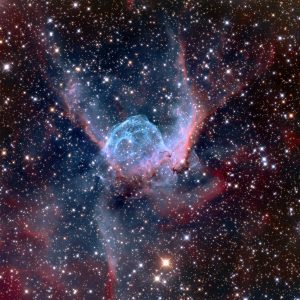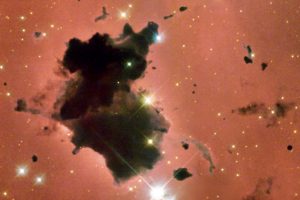Emission nebulae
Emission nebulae are clouds of high temperature gases. The atoms in the cloud are energised by ultraviolet light from a nearby star and emit radiation as they fall back into lower energy states (in much the same way as a neon light). These nebulae are usually red because the predominant emission line of hydrogen happens to be red. Other colours are produced by other atoms, but hydrogen is by far the most abundant. Emission nebulae are usually the sites of recent and ongoing star formation.

Examples
The Orion Nebula is the nearest emission nebula to Earth. It is also referred to as a “diffuse nebula”. Thor’s Helmet is an emission nebula in the Constellation Canis Major. The Eagle Nebula is 7 000 light years distant. It lies in one of the dense spiral arms of the Milky Way galaxy. Within this nebula are the famous Pillars of Creation—towers of dense material that have resisted evaporation by radiation from local young stars.
Reflection nebulae
Reflection nebulae are clouds of dust that reflect the light of a nearby star or stars. It is usually blue because the scattering is more efficient for blue light. Reflection nebulae are also sites of star formation.
NGC 7023, located in the constellation of Cepheus is a Reflection Nebula. It is also known as the Iris Nebula.
Reflection nebulae and emission nebulae are often seen together and are sometimes both referred to as diffuse nebulae.
Diffuse nebulae
Diffuse nebulae are luminous clouds of dust and gas, described as diffuse because of their fuzzy appearance and the fact they cannot be resolved into individual stars. The most notable example is the Orion Nebula, situated south of Orion’s Belt, faintly visible to the unaided eye in the sword of the hunter’s figure in the constellation Orion. It is about 25 light years across, and 1 350 light years away. It is one of the great stellar nurseries, a hectic laboratory of commotion and star formation, and indeed probably the most active area in the universe.
It contains hundreds of very hot (O-type) young stars. The Orion Nebula is also catalogued as NGC 1976 and M42.
Dark nebulae
Dark nebulae, also known as absorption nebulae, are clouds of interstellar dust and gases that are so dense that they obscure the light (in the visible wavelengths) from objects behind them. They are physically very similar to reflection nebulae; they look different only because of the geometry of the light source, the cloud and the earth. Dark nebulae are often seen in conjunction with reflection and emission nebulae.
Probably the most notable is the Horsehead Nebula, some 1 500 light years distant. The horsehead shape is sculpted out of dense stellar material by the radiation from the hot young star, Sigma Orionis.
Another famous candidate is the Coalsack Nebula, which is the most prominent of its type in the night sky. It can be found next to the stars of the Southern Cross. The Pipe Nebula in the constellation of Ophiuchus is another example. Yet another, also of elongated shape, is Lupus 3 in the constellation of Scorpius some 600 light years away. It is part of a larger complex called the Lupus Clouds, which takes its name from the adjacent constellation of Lupus (The Wolf).
These dark clouds are the coldest, most isolated features in the universe, with temperatures of as low as 10° above absolute zero. They are also known as absorption nebulae because they are made up of cold, dense particles of dust that absorb and scatter light as it passes through the cloud.
Bok Globule
A Bok Globule is a small cool cloud of dust and gas responsible for the birth of low-mass stars.

This compact dark nebula is roughly spherical in shape and contains one to a thousand solar masses of material. It has a diameter of between 0.1 and a few light-years. Globules of this kind are believed to be cool concentrations of gas and dust that eventually will collapse to form protostars. Bok Globules are one of the key features of the Lagoon Nebula where there are a large number of dark, comet-shaped clouds of collapsing dust and gas.
They are named after Dutch-born astronomer Bartholomeus Jan Bok (1906 – 1983) who made a detailed study of these objects.
There are Bok Globules in the Lagoon Nebula 5 200 light years away, which also contains young star clusters, and very energetic star-forming regions.
Protoplanetary nebulae
The Boomerang Nebula is a protoplanetary nebula. As the prototype, it is the final phase of most solar mass stars (95% of all stars), being a short-lived episode before dispersing into a planetary nebula.
The Boomerang itself is considered the coldest place in the known universe. Measurements show the nebula has a temperature of only one degree Kelvin above absolute zero (that’s minus 272.15°C). The theory is that the central star, a red giant, has collided with a binary companion, which had been sucked in by extreme gravitational forces. The result is that the gas cloud from the central star is expanding ten times faster than is normally expected, and to a fantastic distance too—some 18 trillion kilometres. It is as if the expanding gas is behaving like a refrigerant, freezing the nebular to a seemingly impossible degree.
The Boomerang Nebula is about 5 000 light years from Earth in the direction of the southern constellation of Centaurus. The name is derived from its symmetric structure as seen from ground-based telescopes. There is a reflecting cloud of dust and gas that has two nearly symmetric lobes (or cones) of matter that are being ejected from the central star. In this way the equivalent of nearly one and a half times solar mass has been lost over the last 1 500 years through an ejection process known as a “bipolar outflow”. The next stage of all this is for the materials to settle down into a planetary nebula.
Planetary nebulae
Planetary nebulae have nothing at all to do with planets. The term was coined in 1785 by William Herschel (1738-1822) because of their disc-like appearance, that through small telescopes they looked a bit like planets. A typical planetary nebula is less than one light-year across.

Planetary nebulae are shells of low-density gas thrown out during the dying stages of low-mass stars in their red giant phase, and this period only lasts about 50 000 years. Their contracting cores will evolve into white dwarfs. Our Sun will probably produce a planetary nebula in about five billion years.
The gas is heated by the ultraviolet radiation given off by the hot inner cores of the dying star. Eventually the material will disperse back into the interstellar medium in the form of hydrogen, nitrogen, and oxygen. The central star of a planetary nebula is among the hottest stars known.
A good example is the Helix Nebula (NGC 7293), which lies 650 light years away in the constellation of Aquarius. It is the closest known planetary nebula to the sun. The nebula’s striking appearance earned it the nickname the Eye of God. It is a good example of the final stage that stars like our Sun will experience before collapsing for the last time.
Another candidate is the Ring Nebula (NGC 6720) in the constellation of Lyra. Its central star is a white dwarf of only about 15th magnitude. The nebula is lit by fluorescence caused by the large amount of ultraviolet radiation emitted by the central star. The rate of the ring’s expansion indicated that the nebula started to form about 20 000 years ago. It was discovered by the French astronomer Antoine Darquier de Pellepoix in 1779. The image here has been colorised to illustrate the nebula’s chemical composition. The deep blue colour in the centre represents helium, the light blue colour of the inner ring is the glow of hydrogen and oxygen, and the reddish colour of the outer ring is from nitrogen and sulphur.
Supernova Remnants
Supernova Remnants are the remains of a stellar event, or leftovers of stellar deaths. Supernovae occur when a massive star ends its life in an amazing blaze of glory. For a few days a supernova emits as much energy as a whole galaxy. When it’s all over, a large fraction of the star is blown into space as a supernova remnant. A typical supernova remnant is at most only a few light-years across.
The Crab Nebula (NGC 1952) is a supernova remnant. It lies in the constellation Taurus, some 6 500 light years distant. It was the year 1054 when Chinese astronomers recorded a star as bright as a full moon, visible in daylight for more than three weeks. They had witnessed a cataclysmic explosion—a supernova—that flung out vast amounts of stellar material that eventually formed the diaphanous filaments we now see as the Crab Nebula. It spans a distance of about 10 light years with a magnitude of between 8 and 9. At the centre is a neutron pulsar spinning at about 30 times a second.
H-II Region
An H-II Region is a glowing region of ionised hydrogen surrounding one or more hot, highly luminous stars. It is often just part of a more extensive cloud of gas and dust, the remainder of which has not been ionised and is therefore not shining. Ionisation is the process of losing or gaining an electron, thus altering the net electrical charge. Positive ions are thus formed when an atom loses one or more of its electrons. (Electrons carry a negative electrical charge). Negative ions result from an excess of electrons.
Back to Top
By Nigel Benetton, science fiction author of Red Moon Burning and The Wild Sands of Rotar.
Last updated: Sunday, 28th February 2021